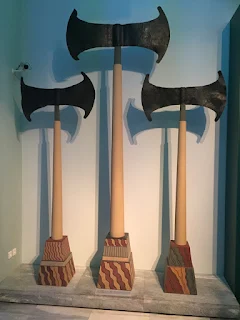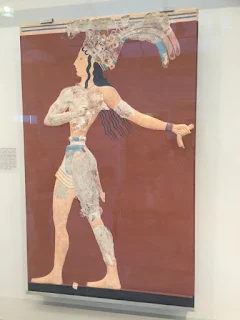Some Art History On Saturday Surf & Culture Report
Lost Boys & Co...
It's Saturday, it's raining and the surf is a blown-out mess. So we thought we'd share a few more pics and you can either take a look or relegate them to the rubbish bin... You either knew or suspected that the Professor started out as an Art History major in college and LoLa minored in Art History. They actually met in an art class (LoLa was better looking than the nude model and she had all her clothes on!)
So if you're not bored to tears yet, here goes...
We headed down to Crete, where the Minoan culture flourished from 3000 BC to around 1500 BC. There's no clear reason why the Minoan's disappeared although the area was susceptible to many catastrophic earthquakes and there's speculation that's why they left and began populating what is now mainland Greece. Crete has amazing history and fabulous temple ruins. It's also the one place we found that we found surf!
#1) We took this shot of these Minoan axes for the benefit of Donnie Souther who uses an axe for his logo. These axes were dated from 3000 to 2000 BC, so they're a cool four to five thousand years old. The double axes were known as "Labrys" and together with the complex layout of the palaces, it is thought that this gave rise to the myth of the Minotaur. They imagine that these axes could have been ceremonial, but they look like they mean business to us.
#2) These are two of the first "Snake Goddesses" that were uncovered by Arthur Evans in 1903. He did a lot of the early excavations of the Knossos Palace grounds. These are beautiful little figurines and are thought to have been cult statues. The snakes suggest the renewal of life, since they regularly shed their skin. Since snakes also burrow into the ground, they are associated with communicating with the under world. The bare breasts of course symbolize fecundity and abundance... or perhaps the sculptors preoccupation with boobs...
#3) This is thought to be an early representation of Lance Carson hanging five at Malibu. Bruce Brown said he looked like he could eat a ham sandwich on the nose. He appears in this depiction to be holding a hot dog instead. We were impressed by the similarities between this representation and similar paintings and reliefs we have seen of Mayan art in the new world. Any connection? If we've learned anything in our travels it's that ancient civilizations were much more sophisticated than one might imagine. The Cretans were a seafaring people and it doesn't seem unrealistic to imagine they could have had some contact...
#4) This is probably the most reproduced Minoan image. It's referred to as "Le Parisiene". It is a painting in the fresco method and was found on a wall in the palace of Knossos. She is thought to be a deity or goddess because of the sacred knot on the back of her hair. When Evans uncovered the fresco he thought she looked like a French woman of the time, thus the name. Over the years it's turned out that Evans was a bit skewed about some of his discoveries. In all fairness, it would be difficult to parse out the particulars after all this time...
#5) This the fresco of the "Bull Jumpers" in the palace at Knossos. There has been this ongoing fascination with bull jumping and bull baiting for centuries. In the Azores they practice Força which involves 5 men tackling a bull head-first and then wrestling it to the ground. France's "Course Landaise" closely resembles the Minoan version with participants making some incredible leaps over the horns of the bull. Why? Bulls have always been venerated as objects of power and strength and if one could channel that power it would attest to the validity of the athlete and in turn the cult. In the Minoan version, the leapers would place their hands behind the bull's head and when the animal would violently jerk upwards they would somersault through the air. Fortunately, southern California has a paucity of bulls, so we surf instead...
✠
"When the surf breaks, we'll fix it"The Professor!!







